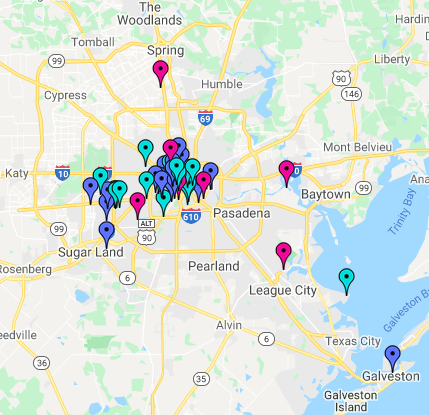 As y’all may know, I have been on a big game kick lately and so I looked up one of my old favorites. Unfortunately, apparently the folks at Board Game Geek and Pagat.com (one of the best links for boardgame rules anywhere) haven’t heard of this version. If you can get four guys sitting around the table with a deck of cards, whether at the lunch room or in a train or really anywhere with a squarish table, this is the version of Big-2 I’d play. We used to play this in junior college and I’ve always tried to teach it to anyone I could. But when you get three other opponents who know what they are doing, it’s an amazing time! I learned the game from the Vietnamese kids at the college so the are the rules I prefer, and definitely much more than the ones that involve Poker hands.
As y’all may know, I have been on a big game kick lately and so I looked up one of my old favorites. Unfortunately, apparently the folks at Board Game Geek and Pagat.com (one of the best links for boardgame rules anywhere) haven’t heard of this version. If you can get four guys sitting around the table with a deck of cards, whether at the lunch room or in a train or really anywhere with a squarish table, this is the version of Big-2 I’d play. We used to play this in junior college and I’ve always tried to teach it to anyone I could. But when you get three other opponents who know what they are doing, it’s an amazing time! I learned the game from the Vietnamese kids at the college so the are the rules I prefer, and definitely much more than the ones that involve Poker hands.
SETUP
Deal out (a pack of 52 standard cards) evenly to each player (for 3 players, deal out 17 to each, the person with the 3-spades can exchange the remaining card).
Winner of the previous throws out the first set. If there was no “previous round” then the player with the 3-spades may start by throwing out a set with the 3-spade or pass (play would pass to the next player).
GOAL
Get rid of your cards (first).
The game ends when all but the last player has gotten rid of all their cards. When someone plays his last set, the next player continues to play, beating the set if she chooses to. If all the remaining players pass on that set, the next player just starts a new set (as if she had one the previous set).
Etiquette has always dictated that you reveal the number of cards in your hand if asked.
CARD RANKING
3 (lowest) 4 5 6 7 8 9 10 J Q K A & 2(highest) Aces are always “14” never “1” Note: runs end at Ace high (2’s may not be used in runs).
The suit order is Spades, Clubs, Diamonds, Hearts. Hearts are the highest.
In cases where there is a number tie the set containing the higher suit wins (ie a pair of 4-clubs&4-diamonds would lose to a pair of 4-spades&4-hearts)
SETS
Single Card
Pair
Three of a Kind
Four of a Kind*
Run of three or more consecutive cards (suit does not matter except for largest card, aces high, runs cannot include 2’s)
Run of Three or more consecutive pairs (ie 44,55,66)*
*these are sets are also called Two-Bombs
TYPICAL ROUND
Each player may play cards to beat the initial initial set or pass. As mentioned previously, the only card that matters is the highest card in a set. Note there is no “rank” between sets – if someone leads with a pair, the round ends with a pair – you can not beat a set with a differnt type of set. So if someone leads with a pair-3 and all you’ve got a J-Q-K in your hand, you get to sit helplessly by until the round ends.
You may also chose to pass. However, if you pass, you must sit out the remainder of the round and may not jump back into this round.
The round ends when three players pass (or have passed in previous turns). At that point, the winner of the set may “pile on” and play additional higher sets of that round (since the other players have passed, they can’t contest his higher sets). For example, the other three players had passed at pair-10, the winner may stack a pair-Jacks, pair-Kings, and pair-Aces before officially ending the round.
The winner of the previous round then begins the next round by playing another set of his choosing. He may choose to play a different kind of set, or play the same type.
TWO-BOMBS
There is only one exception to the rules of “Follow Set Types” and “Sit out of a Round after Passing” and that is the “Two-Bomb”. There are two types of two bombs – a four of a kind and/or a consecutive run of three pairs. Of course a “Two-bomb” set could always be used to start a round, but they can also be played when someone lays a single 2. When that happens, a player (even if she had passed a previous turn in the round), may jump in and drop a two bomb to defeat the 2.
Following players may then defeat the “Two-Bomb”. They must defeat the “Two-Bomb” with the same type of set as the first “Two-Bomb.” In other words, the singles set has now been hijacked by this “Two-Bomb” set and the following players must follow the initial bomb’s set.
Since there are only four of the same number in a deck which limits four of a kinds to bombing a single 2, but one may have more than three consecutive pairs. As such, a run of four pairs would beat a pair-2, and a run of five pairs beat a three-2’s, and presumably a run of six pairs would beat a four-2’s though I imagine the odds are next to impossible for that to happen.
VARIANTS
If playing several rounds consecutively, we usually play that the worst loser has to give up their seat if there is a fifth player waiting.
If people aren’t being shuffled in and out, we usually play that the worst loser has to give their highest card to the winner of the previous round (and the winner gives the loser a card of her choosing).
There are times where we have played with 5 or more players using a combined deck. Generally we’ll deal out thirteen and 5 of a kind can bomb a pair-2.
This game really shines with 4 players – and while I have not tried it yet myself, I’d suggest checking out Dou Di Zhu (Big 3) for three players. For some reason, Big 2 with 17 cards (in a 3 player game) just doesn’t feel right. If anyone has a good climbing Big-2 type game for two people, I’d love to hear about it!
And finally, there are various ways to keep score, but our group never kept track. I heard of some of the guys playing for a 25cents a game, but I don’t gamble so I never played that way.
LAST THOUGHTS
What makes this game strong – and I admit that maybe this works best with me and my playing partners due to extreme familiarity – is that this game is light and fast. It is not a hard game, and you really don’t need to keep track of more cards other than the 2s and the red Aces which are not too many cards. Even so, the game provides situations where you have to make a “hard” decisions. And while individual decisions aren’t particularly hard (I’ve never played this game for money) there are plenty of times when you end up regretting a play because you’ll have to break up a good set to make a decent set.
For example, if you have 4 10 J J Q K A(spade) in your hand and someone plays a pair – do you play the pair-J (which are relatively weak) or do you hang on and wait for someone to play a run? If you don’t jump in at some point you may never get to play a run. And even if you do win with a pair-J, you still have a 4 10 and a QKA(spade) run. If you play the run, there is a good chance that the run will be still be beaten since you have a low ace – if that happens you’ll be sitting there with a medium and really low card. If you play the 4 there’s a good chance that you can get rid of a couple cards, but you’ll most likely still be stuck with a single Q or 10 and watching the table mop up their hands with combo sets. And of course, your opponents are making similar types of choices at the same time. Of course, occasionally you’ll draw a hand that is pretty obvious and plays itself – but even then, there is a thrill of making sure you don’t screw it up.
Unlike big-2 games with poker hands, you never get to just “dump trash” as part of a play – so you often get a great draw that will have just a couple crap cards that will end up forcing how you play your hand. Furthermore, the Two-Bombs create a constant level of uncertainty and surprise that can keep things interesting even if one player is running ahead. Being able to jump in and drop half your hand in one move is a nifty play – but even so, odds are that you had to screw up a couple sets to play the Two-Bomb.
Once you get a group who knows what they are doing – and knows to play fast (and loud!) – you have the perfect recipe for a fun game that is stimulating in that sweet spot of being neither brainless nor brain burning. And I think that’s the definition of a great filler game.










